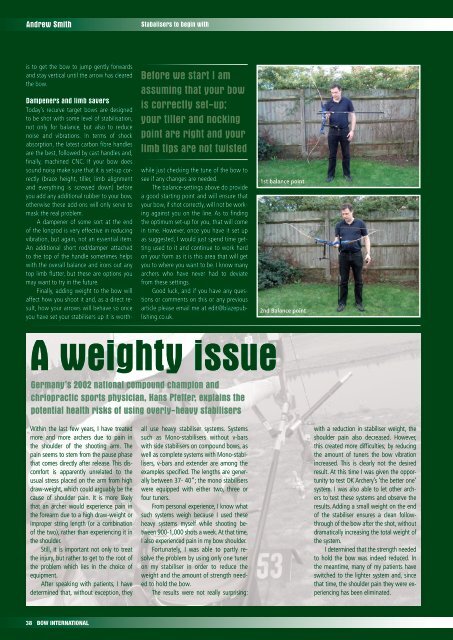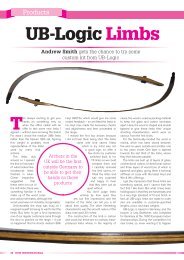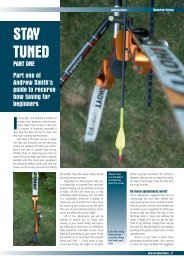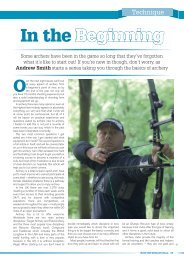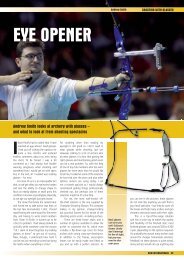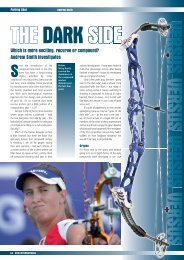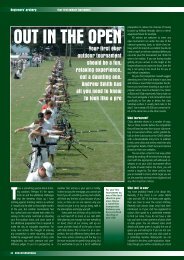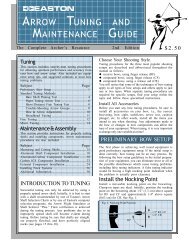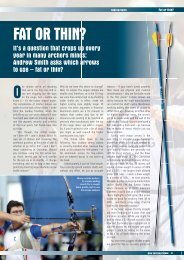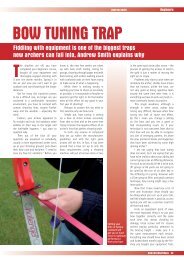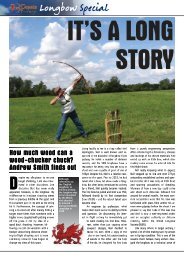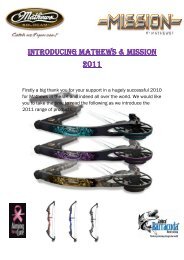Recurve Stabilisation - Perris Archery
Recurve Stabilisation - Perris Archery
Recurve Stabilisation - Perris Archery
Create successful ePaper yourself
Turn your PDF publications into a flip-book with our unique Google optimized e-Paper software.
Andrew Smith<br />
is to get the bow to jump gently forwards<br />
and stay vertical until the arrow has cleared<br />
the bow.<br />
Dampeners and limb savers<br />
Today’s recurve target bows are designed<br />
to be shot with some level of stabilisation,<br />
not only for balance, but also to reduce<br />
noise and vibrations. In terms of shock<br />
absorption, the latest carbon fibre handles<br />
are the best, followed by cast handles and,<br />
finally, machined CNC. If your bow does<br />
sound noisy make sure that it is set-up correctly<br />
(brace height, tiller, limb alignment<br />
and everything is screwed down) before<br />
you add any additional rubber to your bow,<br />
otherwise these add-ons will only serve to<br />
mask the real problem.<br />
A dampener of some sort at the end<br />
of the longrod is very effective in reducing<br />
vibration, but again, not an essential item.<br />
An additional short rod/damper attached<br />
to the top of the handle sometimes helps<br />
with the overall balance and irons out any<br />
top limb flutter, but these are options you<br />
may want to try in the future.<br />
Finally, adding weight to the bow will<br />
affect how you shoot it and, as a direct result,<br />
how your arrows will behave so once<br />
you have set your stabilisers up it is worth-<br />
Within the last few years, I have treated<br />
more and more archers due to pain in<br />
the shoulder of the shooting arm. The<br />
pain seems to stem from the pause phase<br />
that comes directly after release. This discomfort<br />
is apparently unrelated to the<br />
usual stress placed on the arm from high<br />
draw-weight, which could arguably be the<br />
cause of shoulder pain. It is more likely<br />
that an archer would experience pain in<br />
the forearm due to a high draw-weight or<br />
improper string length (or a combination<br />
of the two), rather than experiencing it in<br />
the shoulder.<br />
Still, it is important not only to treat<br />
the injury, but rather to get to the root of<br />
the problem which lies in the choice of<br />
equipment.<br />
After speaking with patients, I have<br />
determined that, without exception, they<br />
38 BOW INTERNATIONAL<br />
Stabalisers to begin with<br />
Before we start I am<br />
assuming that your bow<br />
is correctly set-up;<br />
your tiller and nocking<br />
point are right and your<br />
limb tips are not twisted<br />
while just checking the tune of the bow to<br />
see if any changes are needed.<br />
The balance-settings above do provide<br />
a good starting point and will ensure that<br />
your bow, if shot correctly, will not be working<br />
against you on the line. As to finding<br />
the optimum set-up for you, that will come<br />
in time. However, once you have it set up<br />
as suggested, I would just spend time getting<br />
used to it and continue to work hard<br />
on your form as it is this area that will get<br />
you to where you want to be. I know many<br />
archers who have never had to deviate<br />
from these settings.<br />
Good luck, and if you have any questions<br />
or comments on this or any previous<br />
article please email me at edit@blazepublishing.co.uk.<br />
A weighty issue<br />
Germany’s 2002 national compound champion and<br />
chriopractic sports physician, Hans Pfeffer, explains the<br />
potential health risks of using overly-heavy stabilisers<br />
all use heavy stabiliser systems. Systems<br />
such as Mono-stabilisers without v-bars<br />
with side stabilisers on compound bows, as<br />
well as complete systems with Mono-stabilisers,<br />
v-bars and extender are among the<br />
examples specified. The lengths are generally<br />
between 37- 40”; the mono stabilisers<br />
were equipped with either two, three or<br />
four tuners.<br />
From personal experience, I know what<br />
such systems weigh because I used these<br />
heavy systems myself while shooting between<br />
900-1,000 shots a week. At that time,<br />
I also experienced pain in my bow shoulder.<br />
Fortunately, I was able to partly resolve<br />
the problem by using only one tuner<br />
on my stabiliser in order to reduce the<br />
weight and the amount of strength needed<br />
to hold the bow.<br />
The results were not really surprising:<br />
1st balance point<br />
2nd Balance point<br />
with a reduction in stabiliser weight, the<br />
shoulder pain also decreased. However,<br />
this created more difficulties; by reducing<br />
the amount of tuners the bow vibration<br />
increased. This is clearly not the desired<br />
result. At this time I was given the opportunity<br />
to test OK <strong>Archery</strong>’s ‘the better one’<br />
system. I was also able to let other archers<br />
to test these systems and observe the<br />
results. Adding a small weight on the end<br />
of the stabiliser ensures a clean followthrough<br />
of the bow after the shot, without<br />
dramatically increasing the total weight of<br />
the system.<br />
I determined that the strength needed<br />
to hold the bow was indeed reduced. In<br />
the meantime, many of my patients have<br />
switched to the lighter system and, since<br />
that time, the shoulder pain they were experiencing<br />
has been eliminated.


